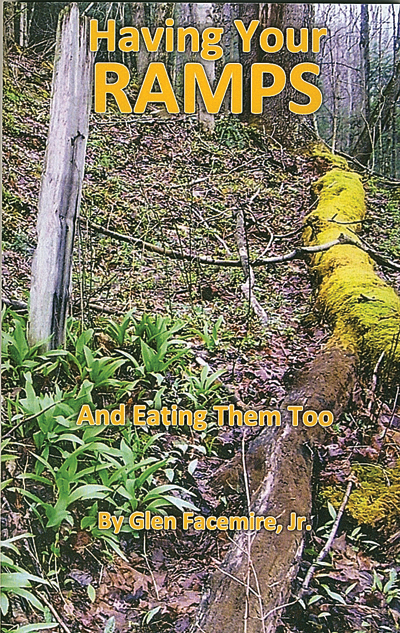
Ramp expert and author Glen Facemire, Jr. was born and raised in Richwood, and digging, selling and eating ramps have been a part of his life for more than six decades.
Facemire spent time in the military prior to beginning his career as a mail carrier for the U. S. Postal Service. That career began in California, but he soon found his way back to West Virginia and, eventually, to Summersville, where he retired after 33 years of service.
It was during his time as a letter carrier that his interest in ramps intensified – and it began with a small spark.
He found himself in a blind one day when he was turkey hunting, and in that blind he found a very small ramp. He had never seen such a dainty-version of his favorite allium tricoccum.
Facemire planted a few ramps here and there along his mail route to observe them as they grew. His postal patrons were excited to find ramps growing in their flower beds or along the side of their houses.
Although he’s given up the mail route, Facemire is still providing ramp seeds and bulbs from his Ramp Farm, an endeavor he shares with his wife, Norene.
Seeds, bulbs and a selection of ramp products may be ordered online a rampfarm.com
He will also answer questions and offer encouragement to first-time growers and he loves to hear from the old-timers, as well.
“Throughout the Appalachian Mountains, ramps were a food source for many wilderness travelers and early settlers,” Facemire writes. “Ramps are on the list of edible plants for survival food in some of the earliest Boy Scout Handbooks.”
Today, ramp dinners have become community social events – not to be missed.
The “aroma” from eating ramps passes nearly as quickly as their harvest season. Ramps only appear from mid-March to mid-May, and there are strict requirements for “ramp digging,” especially on national forest land.
You can learn about the annual cycle of ramps, when and how to gather seeds, how to start your own ramp patch and much more in Facemire’s book, “Having Your Ramps and Eating Them, Too.” Misconceptions about ramps are also addressed.
Most folks like their ramps cooked the old-fashioned way – with eggs or in fried potatoes, served with brown beans and cornbread.
Facemire offers several recipes to “ramp up” your dining options – everything from dips, jelly and candy to meats, vegetables and side dishes.
One of his favorites is Ramp Quiche. He says it freezes well, so you can cook it in season, and serve it later.
Ramp Quiche
1 9-inch deep dish pie shell
12 slices bacon, cooked and crumbled
1 cup Swiss cheese, grated
1 small can mushroom pieces, drained.
1 cup ramps, chopped
4 eggs
1 1/2 cups milk
Combine eggs and milk and beat well. Add remaining ingredients.
Pour into the unbaked pie shell.
Bake in a 350º oven for 45 minutes.
Let stand 10 minutes before serving.
Ramp Stuffing Balls
1 egg, beaten
1/3 cup butter, melted
1/4 cup water
6 oz. pkg. Chicken-flavored stuffing mix
1 cup shredded Swiss cheese
1/2 cup chopped ramps*
Preheat oven to 350º. Blend together egg, butter and water. Stir in stuffing mix, cheese and ramps, mix until well blended.
Shape into one-inch balls.
Place on a greased baking sheet and bake 12 minutes.
Serve warm.
*1/2 cup dehydrated ramps may be used.
Facemire also includes some “ramp humor” in his book. One particular story was of interest because it pertained to the newspaper industry – in a way.
“In the little town of Richwood, the Ramp Capitol of the World, the editor of the local paper, The Newsleader, had his own way of spreading the ramp aroma around. A bushel of ramps was concentrated down to a few ounces of pure smell. It was then added to the ink that would be used to print the paper.”
The paper had subscribers all over the United States – misplaced Hillbillies, including all of West Virginia’s political representatives in Washington, D. C.
“It was a classic scratch and sniff, without the scratch. The post office failed to see the humor of it all and had some ‘strong words’ for the editor.”
As much as we like to spread the word about ramps, we will not be using ramp concentrate to print The Pocahontas Times, but we will share the following information:
In addition to Having Your Ramps, and Eating Them, Too, Facemire has published three booklets, Ramps From the Seed to the Weed, Growing Your Own Ramps and Ramps a Cookin’.
A limited number of copies of “Having Your Ramps, and Eating Them, Too,” are available at The Pocahontas Times office, and may also be ordered online at rampfarm.com



My Mom was from Clover Lick! Now I live here